The oil companies operating in the prolific Stabroek Block offshore Guyana are responsible for the debts incurred and the eventual shut down of their operations as they invest in exploration and production activities, an ExxonMobil official has said.
“There is no responsibility to Guyana or the Government of Guyana for our investments.
“The investments are made by our investors in the project and it’s the projects themselves that need to pay back the investment,” Phillip Rietema, the Vice President and Business Services Manager of ExxonMobil’s local affiliate Esso Exploration and Production Guyana Limited (EEPGL), said on Wednesday.
Rietema further explained that in the unlikely event that exploration activities are unsuccessful, there will be no liability nor debt for Guyana.
His statements come as an international analyst reportedly contended that each Guyanese owe ExxonMobil $9 million, as the company amasses debt to fund oil exploration and production offshore.
Guyana’s Vice President Dr. Bharrat Jagdeo is among those who disagreed with this contention.
Jagdeo on Wednesday noted that citizens would only incur a debt if the State agrees, beforehand to accept that debt. And in this case, Guyana does not have such an agreement.
“…we don’t owe any money, if they [the oil company] can’t pay it back [investors], then [the investors] can levy on the assets of the company but not on [Guyana’s] treasury or the consolidated fund,” Dr Jagdeo emphasised at a press conference.
The Vice President also said that oil companies can only recover their costs when they start producing oil. As such, even if a company spends millions of dollars searching for oil but they are unsuccessful, they stand the costs alone.
If they are successful, they are able to recover the money they invested through a mechanism known as cost recovery. As per the oil contract, the oil companies operating offshore are able to recover up to 75 per cent of their costs when oil revenues are accumulated.
The remaining 25 per cent of revenues is split equally between the companies and the government; the government also gets an additional two per cent in royalties from total revenues.
EEPGL, Hess and CNOOC are co-venturers in the Stabroek prolific block. They share the costs and profits based on their varying stakes in the projects.
Importantly, Rietema also noted that the co-venturers are required to fund the decommissioning of the offshore projects. This essentially refers to the gradual shutting down of the offshore facilities used to produce oil.
“The decommissioning liability is a responsibility of the contractor group and we are responsible for those.
“There is no debt for the people of Guyana or the government,” the company’s Vice President said.
That process of decommissioning is expected some 20 to 30 years in the future; it is the final stage of oil production.
Even so, the company sets aside an amount for decommissioning costs each year, catered for under the cost recovery mechanism. Currently, the co-venturers are drafting a decommissioning security agreement for that future decommissioning.













